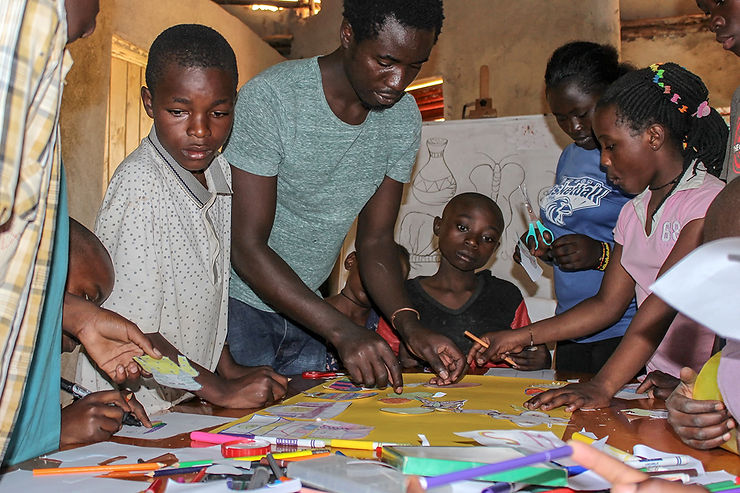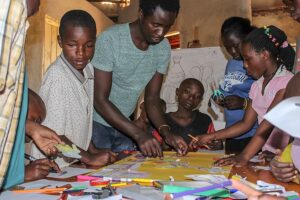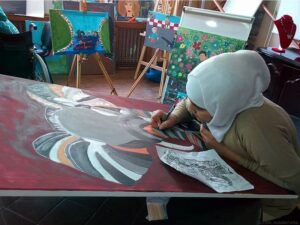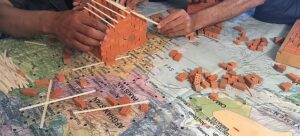
Healing from Conflict, Displacement and Trauma through Expressive Arts
There has been much research exploring the use of the arts with refugees healing from conflict, displacement and trauma. According to the literature, the creative arts therapies (art, music, dance, drama, storytelling and movement) are not only able to connect individuals, but can help promote integration which leads to positive transformation and therapeutic change. Akthar & Lovell (2018) describe how these creative therapies often create a temporary home for refugees in the acculturation process, by serving as a safe and transitional space. This safe space provides the opportunity to heal and gives them a voice.
Much like the recognized health benefits of creative expression for mental health, Dieterich-Hartwell & Koch (2017) identify how art therapy with refugees helps to (1) give them a voice, (2) rebuild trust, (3) share stories and (4) explore their identity and discover their new “self”. Art-making through visual art, music, drama or dance and movement not only represents a safe space in which clients are encouraged to integrate different pieces of their identity through self- and creative- expression, but also helps build the bridge between their homeland and new environment.
Evaluating Art Therapy to Heal the Effects of Trauma Among Refugee Youth: The Burma Art Therapy Program Evaluation concluded that the use of art therapy provided a unique opportunity for refugee youth populations to benefit from a transcultural and positive-framed approach to mental health, and recommended further consideration of the use of creative arts therapies in post-conflict contexts.
Zahra Akthar & Andrew Lovell (2018) Art therapy with refugee children: a qualitative study explored through the lens of art therapists and their experiences, International Journal of Art Therapy, DOI: 10.1080/17454832.2018.1533571
Rebekka Dieterich-Hartwell & Sabine C. Koch (2017) Creative Arts Therapies as Temporary Home for Refugees: Insights from Literature and Practice, Beahvorial Science, 7(4): 69, DOI: 10.3390/bs7040069
From the Field
The following are a couple of examples of how art therapy has helped refugees heal in Uganda and Syria:
Art Therapy: Refugees in Ugandan Camp Using Drawing and Drama to Heal Trauma
Run by refugees from DRC and Burundi, Opportunigee is the first and only entrepreneur network in the Nakivale refugee camp. Members have started art-therapy initiatives to help young refugees heal from conflict and displacement. Art therapy helps provide a supportive environment where the children can talk openly about traumatic experiences, using art to express their feelings and overcome stress.

Syrian Refugees Explore Their Grief Through Art Therapy
An art therapy workshop for Syrian refugees was organized in Jordan. The workshop was meant to give refugee children an opportunity for self-expression, and a way to deal with the trauma they have endured the past five years.

Organization Features
Supporting displaced people through art making and art therapy.
Established in 2006, Art Refuge UK works through art and art therapy with people who have been displaced due to political or religious persecution, armed conflict, trafficking, natural disaster and/or poverty. Their team of artists and art therapists deliver culturally relevant and responsive programmes in a wide range of contexts across the UK, Europe and internationally.

The Red Pencil: Humanitarian Mission
When words are not enough, art can help.
The Red Pencil brings the power of art therapy around the world to children and families who have been through traumatic life circumstances. Their programmes help individuals heal and grow through the arts, by offering an alternative way of expression towards balance, empowerment and resilience.
Transforming Lives through Public Art.
Artolution is a community-based public art organization that seeks to ignite positive social change through collaborative art making. Their projects bring together children, families, local artists, educators and community groups to address critical issues related to armed conflict, trauma and social marginalization by cultivating sustainable global initiatives that promote reconciliation, healing and resilience.

N.E.E.D.S. provides accessible services and support to immigrant and refugee children and youth and their families in Winnipeg, Manitoba. They help provide employment, education and social programs to develop life skills. They also run after-school art programming for children and youth.
Resources
Authored by The University of Winnipeg’s Dr. Jan Stewart and Dr. Lorna Martin, Bridging Two Worlds: Supporting Newcomer and Refugee Youth provides teachers, school administrators and counsellors with practical resources to help students from Kindergarten to Grade 12 navigate school and connect it to careers and their future. More information can be found HERE!
